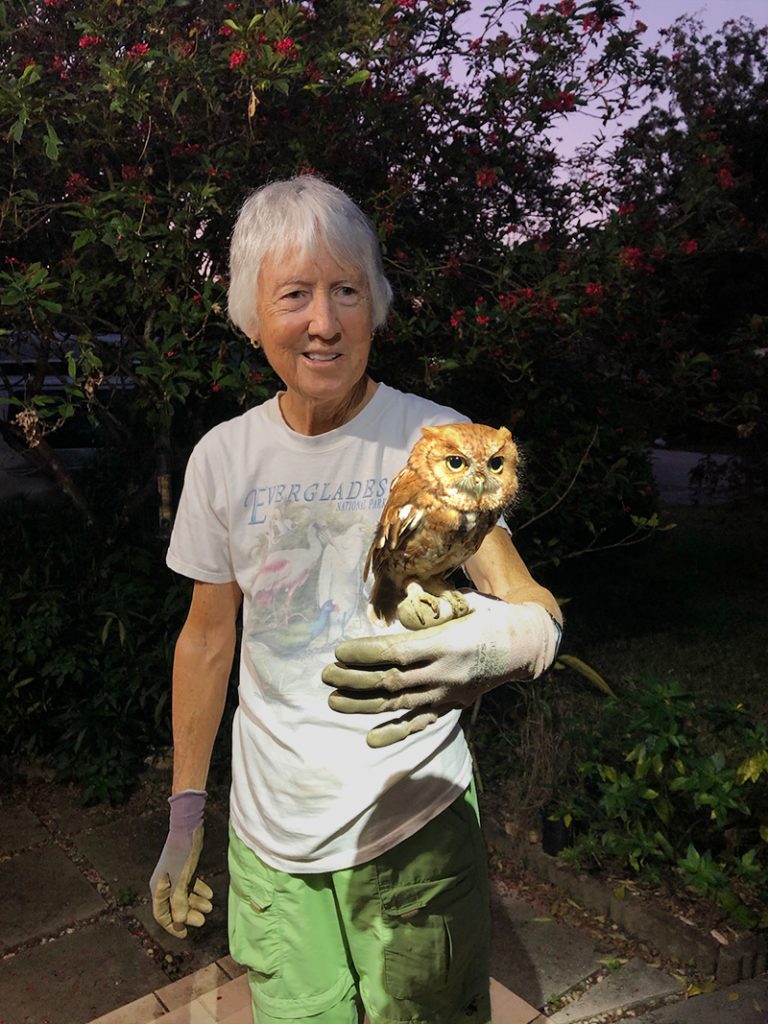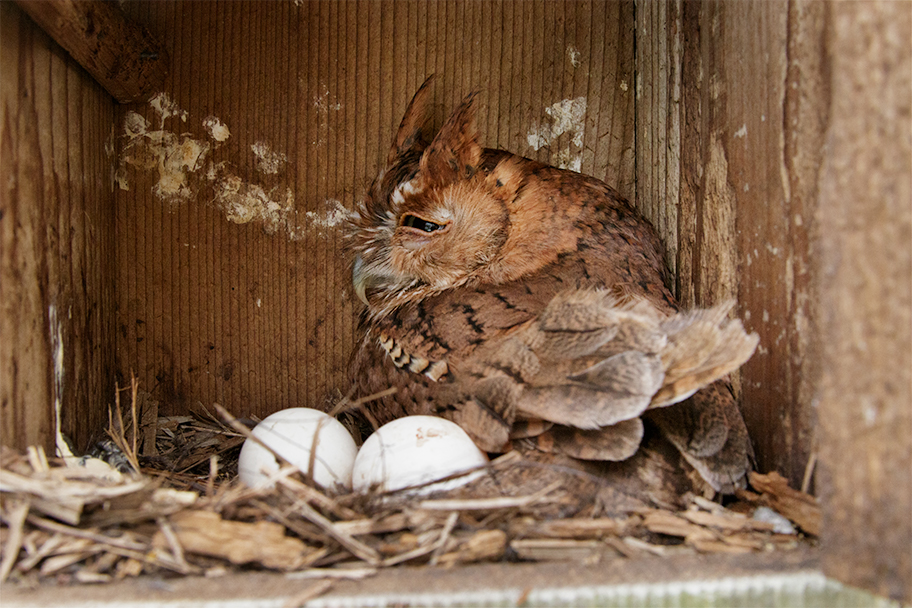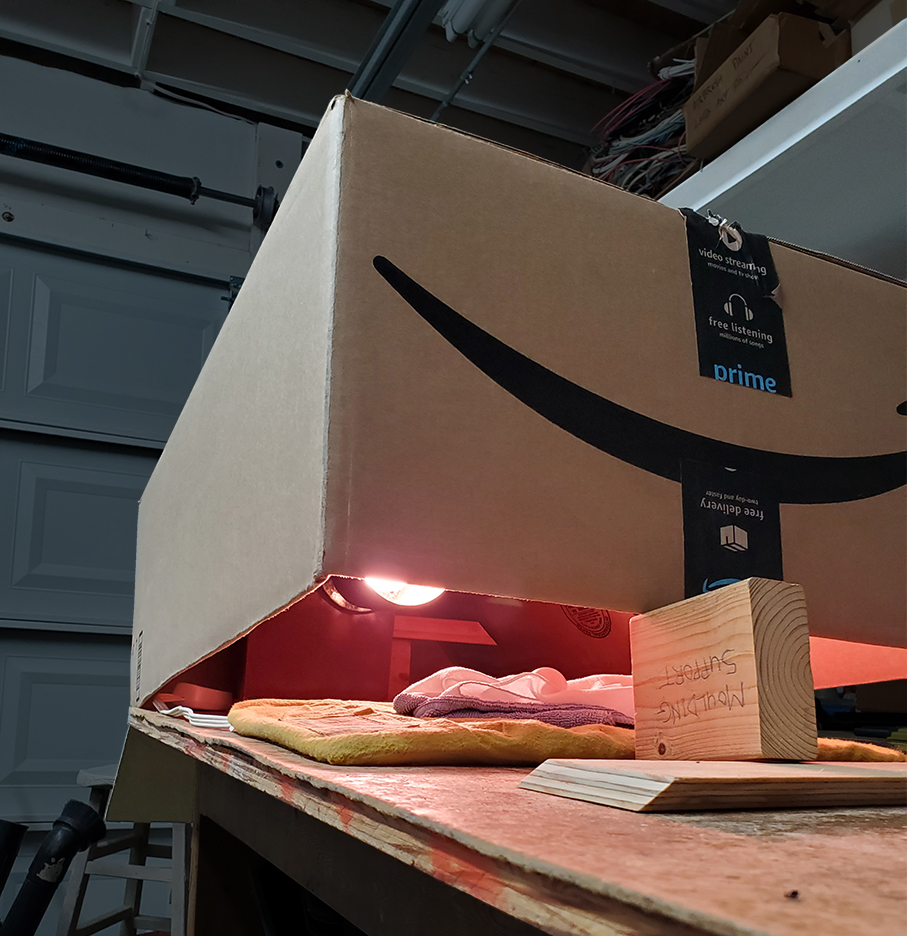Since the nesting screech owls left us (see Our Screech Owl Image – The Rest Of The Story, which is about the subject owl family in our image “Mother Screech Owl with Fledgling” (a link to that page is in the article)), we’ve had a few noteworthy encounters with our local screech owls. In the most recent, we may have saved a life, but I’m getting ahead of myself.
In Our Neighbor’s Yard
A few years ago, we were outside with our good friend and former wild bird rehabilitator April Kirkendoll (whom we last mentioned in Nancy’s Photos Are In Book About Bees), when we heard the blue jays squawking in a neighbor’s mango tree. That usually means a snake or hawk is in the vicinity, so we walked across the street to investigate. As we peered through their chain-link fence, we saw a screech owl fall out of a tree onto the ground. April hopped over the 6-ft fence, retrieved the bird, handed it to Nancy, and then hopped back over the fence. As she inspected the owl, April lifted one wing and then pointed out a large dark area of skin. “This bird has been poisoned!”
We suspect that the owl had caught a poisoned rat (or mouse), possibly still alive but weakened. The poison works by thinning the rat’s blood so much that it ultimately dies from internal hemorrhaging. Whatever eats the rat could suffer the same fate. We buried the owl in the garden.
Nancy, The Rehabilitator
This last January, our next-door neighbor brought us a screech owl that he picked up at the corner 7-11. (See post on our Bee Happy Graphics Facebook page. That photograph was taken by another non-photographer good friend, Isabella Baldovino). That owl had knocked itself unconscious by flying into one of the 7-11 windows. After consulting with April, we monitored it all day, but it was ready to release that evening.

An Owl Returns To Our Nest Box
A few weeks ago, we were excited to notice an owl face looking out the opening of our nest box. Nancy noticed a resemblance to the owl she released in January. She saw the owl several days in a row, and then it disappeared briefly, then came back, and so on. After one absence lasted at least a couple of days, Nancy decided to check the nest box. From the side door, she saw the owl was still there. She was able to pick it up and noticed two eggs. The owl was very lethargic. It didn’t squawk, attack, or even defend its nest. In fact, it would barely open its eyes. We could easily feel the ridge of the breast bone.

Nancy put the owl back in the box and consulted our expert. Together, they theorized that the mate, which we had not seen, may have been poisoned. But before disappearing permanently, brought the poisoned meal to the mother.
We tried force-feeding the mother a small piece of raw chicken, but she wasn’t having any of that. We later brought a small dish of wax worm larvae and chicken pieces and placed them in the nest. The food was gone the next morning, The next dish with larger portions met the same fate. At this point, the owl was a little more lively. We gave her another dish of food. The next morning, the food and the owl were both gone. We left another dish of food, hoping she would return, but the food was still there the next morning, and she was still gone. April had warned us that without the male, she might abandon the nest to save herself. We haven’t seen her since.
What About The Eggs
Screech owls lay their first three eggs a day apart, but then begin to slow down a bitRef 1. Although their average clutch size is four eggs, these owls have been known to have as many as six. April told us that the mother doesn’t start incubating until they are all laid so that they all hatch about the same time.
Plan A
The second day after the mother disappeared, I estimated that the oldest egg must be four days old. We decided we’d better do something about those eggs soon. We called the rehab centers in our area but had to leave messages. They never got back to us. April sent us one link for building an inexpensive incubator (“The $3, 30-Minute Egg Incubator”), but I’m sure there are others online. After reviewing those instructions, we started scrounging up materials. We started with an old heating pad and eventually wound up with the rig shown info Figure 3 below. I learned a few things in the process:

I set it up in the shop so it wouldn’t affect or be affected by the air conditioner. In hindsight, the air-conditioned environment would have been more stable. I started with just the heating pad, which had three settings: just a little low, too high, and way too high. While it was on the medium setting, I tried adding layers of towel as insulation with marginal success. Then I put it on low and added an incandescent light for fine-tuning. These parts were just lying on our shop table. I would change the distance from the bulb to the egg to change the temperature. I was using a neighbor’s (the one who took the picture in Figure 1) old-fashioned oral thermometer and began checking the temperature every five minutes, increasing the time as the temperature stabilized in the target range (99°Ref 2 ±1°).
It turns out the heating pad was a bad idea. After some initial luck, the temperature would swing from one end of its range to the other (and beyond). I concluded that for consistency, the placement of the thermometer was crucial. The problem was that the temperature gradient created by the heating pad was too great; the pad’s surface might be over 100 degrees, but one millimeter away would be substantially less.
Plan B
I unplugged the heating pad and got a box to control the hot air from the lightbulb. Using the box, the distance between egg and bulb wasn’t as critical to the temperature as the height of the open edge of the box, which could be adjusted as needed. And the bulb-heated air temperature was much more consistent throughout the chamber and, more importantly, throughout the egg. I got to the point where I was rotating the egg 1/3 of a revolution four times a day and would only check the temperature twice between rotations (and none at night).
The End Of The Story?
Alas, tragedy struck after three days on the incubator. I won’t go into details but would like to warn you to make sure your box is well supported. Although it was probably too early to tell, candling the remains of the last egg did not reveal any signs of development.
Nonetheless, we will declare this experience a success. Most likely, we saved the mother screech owl from certain death. It is even possible that after a year or so, she will have recovered, found another mate, and could even return to the nest box to raise another family. As for the eggs, the cards were stacked against them from the beginning. According to the Barn Owl Box Company (Ref 1), even under normal conditions, only half of all screech owl eggs hatch (compared to over 80% for some owl species). But these weren’t normal conditions. And what about the father, and this recurring poisoning theme? That is up to all of us. Nancy and I, and many of our friends, will do our part. Will you?
Thanks for listening. If you have any questions, comments, or suggestions, leave them below.
Leave a Reply